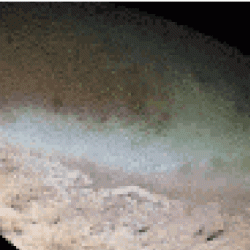Source Institutions
Source Institutions
Add to list Go to activity
Activity link broken? See if it's at the internet archive

In this activity about the solar system, learners use various light sources to examine ice with different components to understand how NASA studies planets and moons from space. This detailed lesson guide includes background information about distant ice worlds in the outer solar system, literature connections, instructions for a pre-activity demonstration, modified activities by age, tips, discussion questions, and resources.
- 45 to 60 minutes
- 1 to 2 hours
- $1 - $5 per group of students
- Ages 4 - 11
- Activity, Demonstration, Lesson/Lesson Plan, Simulation
- English
Quick Guide
Materials List (per group of students)
- Science Notebooks
- Writing and drawing utensils
- Construction paper
- Colored transparencies
- Flat wooden sticks to be used as handles (for example, paint stirrers)
- Several shallow platters in which to freeze ice to model surfaces of an ice world (cookie sheets, cake pans, plastic platters)
- Selection of objects with varying degrees of reflectivity (i.e loose ice cubes, crushed ice loose on a platter, icy water, ice sprinkled with dirt, flour or cake mixture, etc.)
- Various light sources of different intensities (flashlights, bright lamp, sunlight)
- Gallery of images selected from NASA collections
- Ground-based and Hubble images of Pluto and Triton
- Galileo images of Europa
- Images of ice on Earth from space
Subjects
-
Earth and Space Science
-
Astronomy
- Stars and Galaxies
-
Earth Structure
- Oceans and Water
-
Solar System
- The Sun
- The Planets
- Asteroids and Comets
- Origin of Solar System
-
Astronomy
-
Physical Sciences
-
Electricity and Magnetism
- Electromagnetic Fields
-
Light and Optics
- Reflection and Refraction
- Sunlight and Color
- Vibration and Waves
-
States of Matter
- Changes of Phase
-
Electricity and Magnetism
-
Engineering and Technology
-
Engineering
- Aerospace Engineering
- Technology
-
Engineering
-
Mathematics
-
Geometry
- Plane Geometry
-
Geometry
-
The Nature of Science
-
The Scientific Process
- Conducting Investigations
- Formulating Explanations
- Communicating Results
- Science as a Career
-
The Scientific Process
-
The Nature of Technology
-
Technology and Society
- Impacts of Technology
- Technology and History
-
Technology and Society
Audience
To use this activity, learners need to:
- see
- see color
- read
- be mobile
- touch
Learning styles supported:
- Involves teamwork and communication skills
- Involves hands-on or lab activities
Other
Includes alignment to state and/or national standards:
Includes assesments for student learning:
This resource is part of:
Access Rights:
- Free access
By:
- Carnegie Institution of Washington - Carnegie Academy for Science Education
Rights:
- All rights reserved, Johns Hopkins University/Applied Physics Laboratory, 2011
